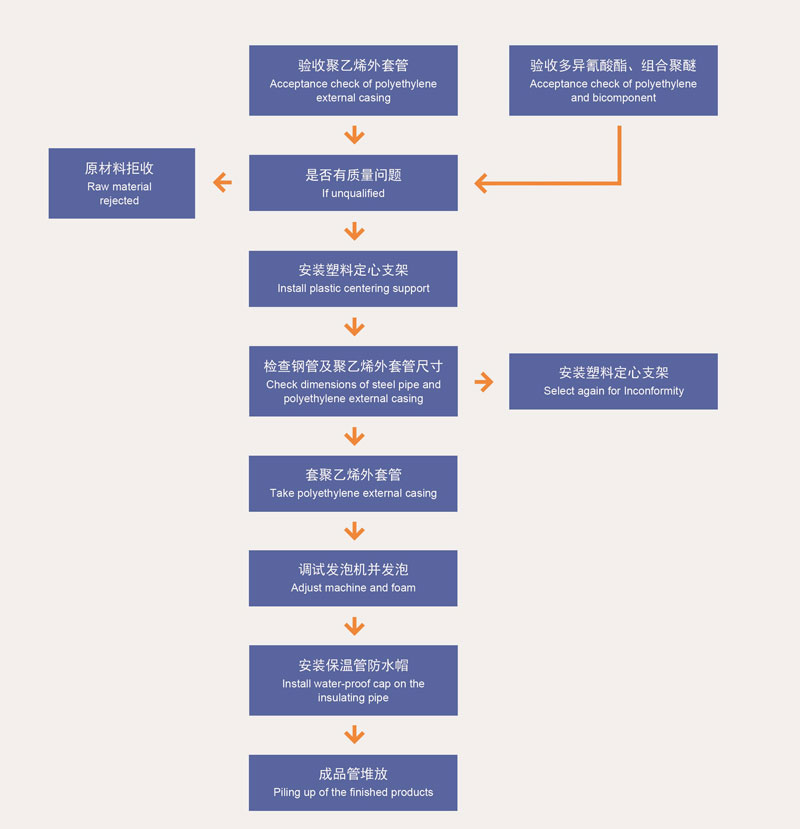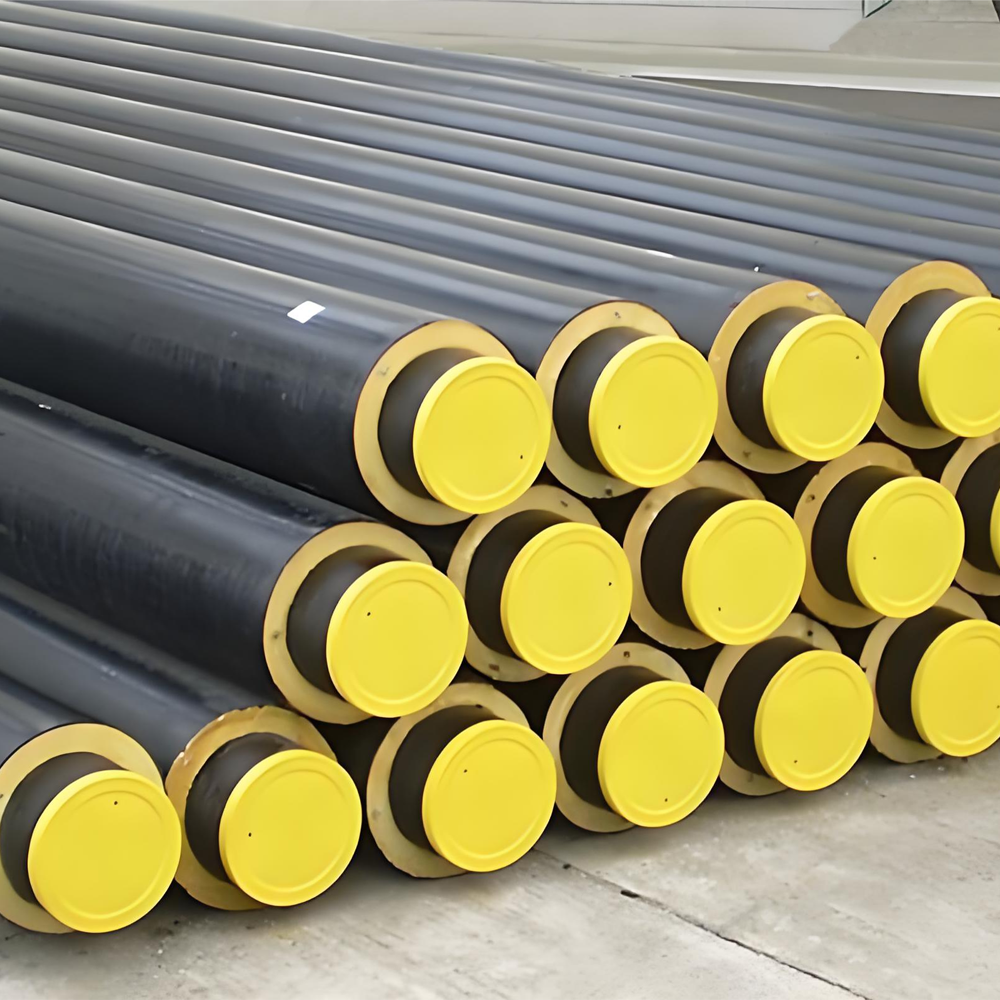EN 253 Polyurethane Foam Pre-insulated Steel Pipe
- Steel Service Pipe OD: DN15-DN1200 (21.3-1219mm); WT:2-12.5mm
- Outer PE Casing OD: 75-1400mm; WT:3-12.5mm
- Structure: Steel Service Pipe + PU Foam + Outer PE Casing
EN 253 Polyurethane Foam Pre-insulated Steel Pipe
Our EN 253 polyurethane foam pre-insulated steel pipes offer a unique combination of thermal insulation and corrosion protection for demanding applications in the oil and gas, petrochemical, and industrial sectors. Made from high-quality steel with a thick layer of polyurethane foam insulation, these pipes provide exceptional thermal insulation and mechanical protection against corrosion and damage. The polyurethane foam is fully encapsulated within the pipe, ensuring a durable and consistent insulation performance over time. With their ability to withstand extreme temperatures, chemicals, and mechanical stress, EN 253 pre-insulated steel pipes are ideal for use in onshore and offshore pipelines, refineries, chemical plants, and other industrial settings where temperature control and safety are critical.
Specifications
| Standard | EN 253 District heating pipes – Preinsulated bonded pipe systems for directly buried hot water networks – Pipe assembly of steel service pipe, polyurethane thermal insulation and outer casing of polyethylene |
| Steel Service Pipe Dimension | OD:DN15-DN1200 (21.3-1219mm); WT:2-12.5mm |
| Outer PE Casing Dimension | OD:75 – 1400mm; WT:3-12.5mm |
| Length | 6-14m |
| Steel Service Pipe | EN 10216-2 P235GH, EN 10217-1 P235TR1/TR2, EN 10217-2 P235GH, API 5L GR.B |
| Packing | PE/BE, plastic cap, Loosely Packed |
| Technique | Steel Service Pipe + PU Foam + Outer PE Casing |
| Service condition | Hot water network |
| Place of origin | Made in China |
| MOQ | Depends on project requirements |
| Transportation | Land by Truck, Railway, Sea |
| The minimum thickness of the protective layer and insulation layer
for conveying the media below 100℃ (mm) |
|||
| Forming Process | Outer Diameter | Axial eccentricity | The minimum thickness of the protective layer |
| One-stop Method | Ф48-144mm | ±3 | ≥1.4 |
| Ф159-377mm | ±5 | 1.6 | |
| > Ф377mm | ±5 | 1.8 | |
| Pipe-in-pipe | ≤ Ф159mm | ±3 | 2 |
| Ф168-245mm | ±4 | 3 | |
| Ф273-377mm | 4 | ||
| ≥ Ф426mm | ±5 | 4.5 | |
| Outer diameter and the minimum wall thickness of protection pipe of insulation pipe for conveying media between 100℃~120℃ (mm) | |||||||||||
| OD | 110 | 125 | 140 | 160 | 200 | 225 | 250 | 280 | 315 | 355 | 365 |
| Min.WT | 2.5 | 3 | 3.2 | 3.5 | 3.9 | 4.4 | 4.9 | 5.6 | |||
| OD | 400 | 420 | 450 | 500 | 550 | 560 | 630 | 655 | 710 | 760 | 850 |
| Min.WT | 6.3 | 7 | 7.8 | 8.8 | 9.8 | 11.1 | 12 | ||||
| OD | 950 | 955 | 995 | 1045 | 1155 | 1200 | |||||
| Min.WT | 12 | 13 | 12 | 13 | 14 | 14 | |||||
| Note: Other protection pipes can be used according to the customers’ requirements, but the minimum thickness of protection pipes should be as per the interpolation method in the table above. | |||||||||||
Polyurethane foam thermal insulation coating process

Applications of EN 253 Polyurethane Foam Pre-insulated Steel Pipe
EN 253 is a European standard that specifies requirements for pre-insulated bonded pipe systems for directly buried hot water networks. The pipes consist of a steel service pipe, polyurethane foam insulation, and an outer casing of polyethylene. Here are some common applications of EN 253 polyurethane foam pre-insulated steel pipes:
District Heating and Cooling Systems:
Used extensively in district heating networks to transport hot water or steam from central plants to residential, commercial, and industrial buildings.
District cooling systems use these pipes to distribute chilled water.
Industrial Piping Systems:
Utilized in industrial settings where thermal insulation is crucial to maintain the temperature of fluids over long distances, such as in chemical plants, refineries, and food processing industries.
Underground Piping Networks:
Ideal for underground piping systems due to their corrosion resistance and durability.
Often used in cities and municipalities for infrastructure that requires thermal efficiency and minimal heat loss.
Hot Water Supply Systems:
Applied in large residential complexes and institutional buildings for hot water supply, ensuring minimal heat loss and energy efficiency.
Renewable Energy Projects:
Used in systems involving solar thermal energy and geothermal heating where maintaining high temperatures is essential for efficiency.
Suitable for bioenergy projects involving biomass heating systems.
Refrigeration Systems:
Can be used in some refrigeration systems where long-distance transport of cooled liquids or gases is necessary, though this is less common compared to heating applications.
Oil and Gas Industry:
Sometimes used in oil and gas pipelines, especially in regions with extreme temperatures where maintaining the temperature of the transported medium is critical.




